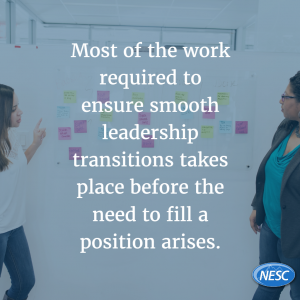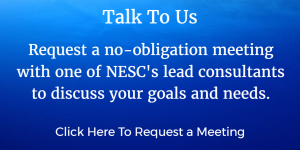 Developing leadership at all levels – and retaining high-performance employees in a competitive talent market – is one of the most important things a nonprofit organization can do to ensure its sustainability and success. This means building and cultivating a pipeline of high performers and leaders, and taking steps to plan for leadership transitions before there are open positions that need to be filled.
Developing leadership at all levels – and retaining high-performance employees in a competitive talent market – is one of the most important things a nonprofit organization can do to ensure its sustainability and success. This means building and cultivating a pipeline of high performers and leaders, and taking steps to plan for leadership transitions before there are open positions that need to be filled.
Yet only 34% of nonprofits report that they have a written succession plan in place.
For existing staff, nonprofits must develop their competitive edge by creating and managing talent pools for mission-critical roles, identifying skills gaps and aligning development opportunities to prepare their employees for current and future needs.
At the same time, nonprofits who are serious about their own sustainability will also be serious about planning for transitions of leadership – making sure their nonprofit is prepared for expected departures such as retirements, as well as for unexpected departures.
Ensuring Smooth Leadership Transition
Most of the work required to ensure smooth leadership transitions takes place before the need to fill a position arises. By taking a deeper approach to succession planning, you will be better prepared for both planned and unexpected transitions, and you will reduce the disruption and risks of executive transition.
Before you have an opening:
Planning
- Identify current challenges and those that lie ahead, and the corresponding leadership qualities that are needed to navigate these challenges successfully.
- Conduct a replacement review of all management positions, including a review of job descriptions and key functions and roles, along with an emergency backup plan for the senior staff.
- Succession planning should include a longer-term effort to bring all staff compensation – including the executive director’s – into line with the market. In addition to finding it more difficult to attract top performers, organizations that don’t pay competitively tend to have higher turnover, with a corresponding cost in terms of both forgone revenue and recruiting and training expenses.
- If you are anticipating a leadership change (e.g., due to retirement), draft a timeline that includes all the steps that will be taken before, during, and after the actual transition.
- Put policies in place to ensure that knowledge transfer is done on an ongoing basis. Document all processes, contacts, etc., so that the functions of any executive can be handled by others if they leave the organization.
Training & Development
- Cross-train current staff to minimize the disruption from unexpected staffing changes.
- Identify leadership development opportunities for staff and board members to expand their leadership skills so that the organization will have a “deeper bench” of future leaders.
- Make plans to properly support new employees, such as with coaching, mentoring, and defining clear, measurable goals.
Communication & Engagement
- Gain the commitment of both the board and staff to creating a formal process to manage succession transition.
- Plan ahead on how your organization will communicate – what your organization will say to stakeholders before, during, and after a transition of leadership.
Culture & Change
- Transform the fear of executive transition into a proactive, empowering opportunity to increase focus on mission and on the leadership team needed to achieve the desired results.
- Expand the culture and practices of leader development, inclusion, and diversity.
- Consider the possibility of new approaches to sharing power and leadership. Executive transitions are often an excellent opportunity to evaluate and optimize the organizational structure to meet both current and future needs. For example, you may want to address shifts in funding and the political environment, and rethink the connection between mission, strategy, and how the work of the organization is supported. Considering new approaches may be especially relevant to organizations with long-tenured or founder executives.
When You Have An Opening:
- If a departing executive director cannot stay until a replacement is found, consider placing an interim leader at the helm of your nonprofit while recruiting new leadership. This could be a current executive, a board member, or an outsider. But be clear on whether that person will be considered for the position permanently, and on what their role will be after the new executive director is hired.
- Adopt an Emergency Leadership Transition Plan to address the timely delegation of duties and authority whenever there is an unexpected transition or interruption in key leadership.
- For senior positions, unless you have an obvious internal candidate, bring in outside expertise to help you with the search. An executive search firm can greatly expand your access to external candidates and also help ensure that you find a leader who is an excellent fit for both your current and future needs.
- Consider all candidates, both internal (staff and board members) and external, for new leadership.
Who is Responsible for Planning for Transitions of Leadership?
A committee of the board, such as the Governance Committee or Executive Committee, will generally focus on leadership succession at the board level, while staff leaders are most often charged with identifying transition plans for staff’s leadership succession. Because the board is ultimately responsible for oversight of the executive director, typically it is also the board’s role to initiate succession planning for the executive director/CEO. Helping the departing leader leave well will pave the way for a smooth on-boarding experience for the new leader.
Why Succession Planning is Important:
For a nonprofit organization, the potential impact of poor succession planning goes well beyond the short-term operational disruption during the changeover. A poor leadership transition can leave an organization vulnerable to environmental stresses, such as a loss of external funding because long-time donors may take a “wait and see” approach to the new leadership, or the loss of institutional knowledge when a long-tenured leader takes information with him/her about relationships or other expertise.
Hiring the right leadership is perhaps the most important decision that a nonprofit board can make. The search process behind this decision can be long and unruly, or it can be thorough and productive. By planning ahead, breaking down the process into tasks, and conducting them with integrity, search time can be spent wisely and good decisions can be made.
Agree? Disagree? Share your thoughts in the Comments below.

